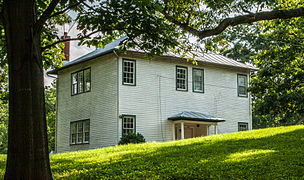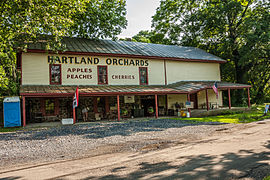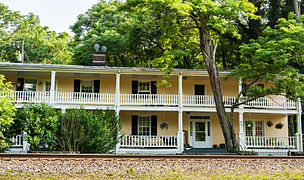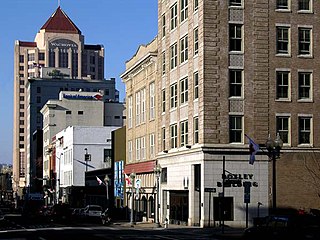
The Roanoke Downtown Historic District is a national historic district located in the Downtown Roanoke area of Roanoke, Virginia. It encompasses 122 contributing buildings. It includes a variety of commercial, institutional, social, and governmental buildings and structures from the late 19th century to the mid-20th century. Notable buildings include the Roanoke City Public Library, the YMCA Central Branch Building, First Christian Church (1925), the Central Church of the Brethren (1924), Tomnes Cawley Funeral Home (1928), Thomas B. Mason Building (1961), Peerless Candy Co., City Hall / Municipal Building (1915), Roanoke Times Building (1892), Anchor Building / Shenandoah Building (1910), Greene Memorial Methodist Church (1890), and United States Post Office and Courthouse (1930). Located in the district are the separately listed Patrick Henry Hotel, Boxley Building, Campbell Avenue Complex Historic District, Colonial National Bank, and First National Bank.

The Lovingston Historic District is a national historic district located in Lovingston, Virginia, USA. It is a 224.8-acre (0.910 km2) historic district which includes the entirety of the 1809 and 1823 plats as well as the continued growth through the early-to-mid-20th-century. The cohesive village contains a diverse collection of building types and architectural styles that reflect the town's growth and development as the seat of Nelson County from its inception to the present. It consists of 105 properties with 176 total resources, including the Nelson County Courthouse listed separately on the National Register of Historic Places, forty-nine single dwellings, twenty-four commercial structures, six multiple dwellings, twenty-five sheds, three churches, five tavern/hotels, eleven offices, a theater, a cooper shop, a packing shed, a post office, a bank, a cemetery and two statues.

Farmville Historic District is a national historic district located at Farmville, Prince Edward County, Virginia. It encompasses 246 contributing buildings and 1 contributing object in the central business district and surrounding residential areas of Farmville. It includes a variety of commercial, residential, institutional, and industrial buildings dating from the mid-19th to early-20th centuries. Notable buildings include the Paulett-Gill house, Farmville Presbyterian Church, Johns Memorial Episcopal Church (1881), Farmville Methodist Church (1907), Hotel Weyanoke (1925), the warehouses of the Dunnington Tobacco Company and Central Virginia Processing, Inc., the former Craddock-Terry Shoe Company, the former Cunningham and Company tobacco prizery, Norfolk and Western Railroad passenger station, Doyne Building, the Watkins M. Abbitt Federal Building (1917), Prince Edward County Courthouse, and the former Farmville High School (1913). Located in the district is the separately listed First Baptist Church.
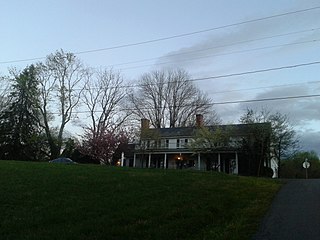
Cartersville Historic District is a national historic district located at Cartersville, Cumberland County, Virginia. It encompasses 51 contributing buildings and 2 contributing sites in the village of Cartersville. Most of the buildings date to the turn of the 20th century, with a number of late-18th- and 19th-century dwellings and former taverns, two churches, a few commercial buildings, a post office, and a former school. Notable buildings include the Deanery (1780s), Glaser House (1790s), Baptist Parsonage (1790s), Cartersville Tavern, Cartersville Baptist Church, St. Catherine's Catholic Church (1910), Cartersville Methodist Episcopal Church (1883), Cartersville Post Office (1910), Cartersville Bank, Culbertson House, H. T. Harrison House, and W. E. Robinson House, Newstead Manor.
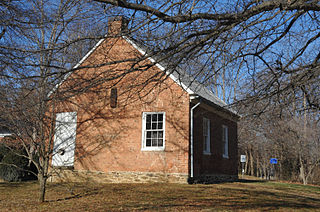
The Goose Creek Historic District is a rural landscape in the Goose Creek valley of Loudoun County, Virginia. The district covers about 10,000 acres (4,000 ha) south of Hamilton and Purcellville and includes the village of Lincoln. The majority of the district is farmland, with areas of forest along Hogback Mountain. The area was settled by Quakers in the mid-18th century, represented by simple houses and the Goose Creek Meetinghouse Complex in Lincoln, separately listed on the National Register of Historic Places. About 270 buildings lie within the district. The district includes 44 stone buildings, reflecting the popularity of this material in the 18th and 19th centuries in this area. Many houses have outbuildings and barns built in a manner complementary to the dwellings. By the mid-19th century, materials turned to brick, with the Glebe of Shelburne Parish an NRHP-listed example of a brick Federal style house, as well as the Israel Janney House.

Long Marsh Run Rural Historic District is a national historic district located just outside Berryville, in Clarke County, Virginia. It encompasses 315 contributing buildings, 16 contributing sites, and 35 contributing structures. The district includes the agricultural landscape and architectural resources of an area distinctively rural that contains numerous large antebellum and postbellum estates, and several smaller 19th-century farms, churches, schools and African-American communities.

Casanova Historic District is a national historic district located at Casanova, Fauquier County, Virginia. It encompasses 32 contributing buildings in the rural crossroads of Casanova. They include a variety of late-19th and early-20th century dwellings, the former Casanova Store, a two-story stone mill converted to a dwelling, the Gothic Revival style Grace Church Parish Hall, a former school, and a former garage converted to a post office in the 1950s.

Sumerduck Historic District is a national historic district located at Sumerduck, Fauquier County, Virginia. It encompasses 19 contributing buildings and 1 contributing site in the rural hamlet of Sumerduck. The Reconstruction-era district includes dwellings that date from the late-19th to the mid-20th centuries, stores, churches, a post office, a school, and a public space for meetings. Notable buildings include the Tulloss House, the Henry Broadus Jones House also known as the Santa Claus House or the House of the Seven Gables, the restored Embrey-Mills House (1880s), the Steven Jacobs House, the Union Primitive Baptist Church, Sumerduck Baptist Church (1915), a former school (1887), and Sumerduck Trading Company.

Remington Historic District is a national historic district located at Remington, Fauquier County, Virginia. It encompasses 131 contributing buildings, 1 contributing site, and 2 contributing structures in the rural village of Remington. The district consists primarily of late-19th- and early-20th-century dwellings, churches, and commercial buildings that illustrate the town's growth and development. Notable buildings include the Rouse House, Remington Methodist Church (1872), St. Luke's Episcopal Church (1881), Remington Baptist Church (1884), the Daniels House, Remington Farmer's Co-op Building, Groves Hardware Building (1905), and the State Bank of Remington (1913).
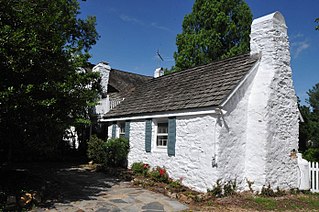
Rectortown Historic District is a national historic district located at Rectortown, Fauquier County, Virginia. It encompasses 76 contributing buildings, 3 contributing sites, and 2 contributing structures in the rural village of Rectortown. The district includes dwellings dating back to the 18th century, churches, a school, an Odd Fellows hall, a post office, multiple commercial buildings, and several cemeteries that illustrate the town's growth and development. Notable buildings include the Maidstone Ordinary, the Rector-Slack Log House, the Ashby House, the Georg Mann House, The Brick Store House, Rector's Warehouse and Station, Denham, Maidstone, Rectortown United Methodist Church (1894), the Jackson-Grant House (1924), Slack's Store (1890), and the Mt. Olive Odd Fellows Lodge (1935).

Greater Newport Rural Historic District is a national historic district located near Newport, Giles County, Virginia. It encompasses a total of 737 contributing buildings and 25 contributing structures in the rural area near the village of Newport. It encompasses the previously listed Newport Historic District. The district includes primarily 19th- and early-20th-century farmsteads and complexes. Notable buildings include the "Camper" Cabin, Albert Meredith Cabin, E. L. Lucas House, Moses Atkins House (1837), William Lafon House (1855), Doak Lucas House (1860), Leonard Kessinger House (1871), Martin Farrier House (1905), Steve and Lori Taylor House (1938), Upper Spruce Run School (1890), Clover Hollow Christian Church (1921), Sherry Memorial Church, Old Cook Mill, three standing diminutive Burr covered bridges, a smelting furnace (1871), the Mountain Lake Hotel Resort, and the Biological Station of the University of Virginia (1934).

Fieldale Historic District is a national historic district located at Fieldale, Henry County, Virginia. The district encompasses 329 contributing buildings and 2 contributing structures in the town of Fieldale. The majority of the buildings were built after 1916-1917 by the Marshall Field and Company as workers housing for the Fieldcrest Mills. Other notable buildings and structures include the Fieldcrest Mills Complex with the upper mill, lower mill, gatehouse, warehouse, water infiltration plant, and welder's shop; Danville & Western Station; Route 701 Bridge; Bank of Fieldale/Post Office; Fieldale Café (Fieldale Grocery; former Theater/Drug Store; Ramona's Dress Shop/Wilson's Grocery Store; Fieldale Elementary School ; Fieldale High School ; Fieldale Community Center ; Fieldale Hotel, and Fieldale Baptist Church. The former gas station building that houses Peggy's Antiques was built by the Lustron Manufacturing Company. Also located in the district and separately listed are the Marshall Field and Company Clubhouse and Virginia Home.

McClung Farm Historic District is a historic home and national historic district located at McDowell, Highland County, Virginia. The district encompasses seven contributing buildings, three contributing sites, and three contributing structures. The main house was built in 1844, and is a two-story, five bay, brick dwelling with a single-pile, central-passage plan and an original two-story rear addition in a vernacular Federal style. It has a three bay wide front porch. The contributing buildings and structures besides the house include: a large barn, a small barn, a cattle ramp, an outhouse, a corncrib, a smokehouse, a shed, and the Clover Creek Presbyterian Church and its outhouse. The contributing sites are a wood shed foundation, the ruins of the McClung Mill, and the Clover Creek Presbyterian Church cemetery.

Shenandoah Historic District is a national historic district located at Shenandoah, Page County, Virginia. The district includes 451 contributing buildings, 3 contributing sites, and 4 contributing structures in the town of Shenandoah. They include residential, commercial, and institutional buildings in a variety of popular late-19th century and early-20th century architectural styles. Notable buildings include the Eagle Hotel and annex, Norfolk and Western Railway YMCA, Shenandoah General Store, Fields United Methodist Church, Christ United Methodist Church, St. Peter's Lutheran Church, Norfolk and Western Railway Station, and Shenandoah High School. Located in the district is the separately listed Shenandoah Land and Improvement Company Office.

Chatham Historic District is a national historic district located at Chatham, Pittsylvania County, Virginia. The district includes 188 contributing buildings, 2 contributing sites, and 1 contributing object in the central business district of the town of Chatham. The district includes a variety of government, commercial, residential, religious and educational buildings and structures dating from the early-19th century to the mid-20th century. At the center of the district is the separately listed Pittsylvania County Courthouse. Other notable buildings include the Judge Tredway House, Tunstall-Hargrave House, The Oaks (1832), Morea (1837), Hugh Weir House (1835), Planter's Bank, Thompson's Drug and Haberdashy Building, Corinth Christian Church, Emmanuel Episcopal Church (1881), Chatham Presbyterian Church (1886), Canada-Melton House, United States Post Office, Chatham High School, Chatham Elementary School (1925), Chatham Savings Bank, Masonic Temple, Collie Hotel/William Pitt Hotel, Beauty Plaza, and the Moses Building. Also located in the district and separately listed are the Clerk's Office, Bill's Diner, and Burnett's Diner.

Buckland Historic District is a national historic district located at Buckland, Prince William County, Virginia. It encompasses 30 contributing buildings, 11 contributing sites, and 6 contributing structures in the town of Buckland. The district is centered on a grist mill, Buckland Mill, the third such structure located on the site. Besides the mill, the most significant buildings include an early 19th-century wagon tavern and a small church. For the most part the houses are small, simple, 19th-century dwellings constructed of log, frame or stone; most were intended to serve a commercial as well as a residential purpose. Other contributing resources include the mill race and dam, Cerro Gordo plantation, portions of the Civil War Buckland battlefields, the Kinsley Mill and miller's house, and Buckland Hall.

Edinburg Historic District is a national historic district located at Edinburg, Shenandoah County, Virginia. The district encompasses 292 contributing buildings, 6 contributing sites, 3 contributing structures, and 3 contributing objects in the town of Edinburg. It includes a variety of commercial, residential, and institutional buildings dating primarily from the time of its incorporation in 1852 to the mid-20th century. They are in a variety of popular architectural styles including Colonial Revival, Italianate, and Queen Anne. Notable buildings include the Philip Grandstaff House (1787), Edinburg Hotel, St. John's United Methodist Church (1916), Edinburg High School (1932-1933), Rush House, The Hatch, Piccadilly House (1850), Pres Grandstaff House, Masonic Building (1879), Harshman House (1900), Rest Haven Inn, Edinburg Train Station, Edinburg Village Shops (1896), Wrenn Building, Edinburg Town Hall (1903), St. Paul's United Church of Christ (1911), and the Mantz House (1930). Located in the district is the separately listed Edinburg Mill.

Covington Historic District is a national historic district located at Covington, Virginia. The district encompasses 108 contributing buildings, 1 contributing site, and 1 contributing structure in the historic core of the city of Covington. It includes late-19th and early-20th-century commercial buildings, dwellings that date from around 1820 until 1940, and governmental, educational, religious, industrial, and transportation-related buildings. Notable buildings include Merry Stand, the James Burk House (1824), Callaghan House (1840s), William W. Lawrence House (1850s), Rinehart Building, Covington Savings Bank (1910s), I. O. O. F. Building, Covington Post Office (1914), Hotel Collins (1910), Hippodrome Theater (1920s), C&O Railway and Freight Station (1914-1915), Alleghany County Courthouse (1910), Alleghany County Jail, Sacred Heart Catholic Church, Emmanuel Episcopal Church, First Presbyterian Church (1924), and Covington Baptist Church (1902).
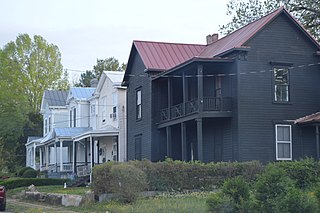
Holbrook–Ross Street Historic District is a national historic district located in Danville, Virginia. The district includes 107 contributing buildings in a primarily African-American neighborhood of Danville. It includes a full range of late 19th and early 20th century residential, commercial, and institutional structures. The majority of the houses are single-family dwellings that were built between 1880 and 1910, and includes notable examples of vernacular Italianate and Queen Anne styles. Notable buildings include the Williams House, Hargraves-Geary House, Tisden House, Leroy Johnson House, Broadnax Apartment, Calvary Baptist Church (1896), Holbrook Street Presbyterian Church, Loyal Baptist Church (1924), Wesley AME Church (1939), Westmoreland Middle School (1936), and the Annex Building (1925). Located in the district are the separately listed Hotel Danville and the Danville Municipal Building.

The Laburnum Park Historic District is a national historic district located at Richmond, Virginia. The district encompasses 226 contributing buildings and 2 contributing structures located north of downtown Richmond. The primarily residential area developed starting in the early-20th century as one of the city's early "streetcar suburbs" and as home to several important local institutions. The buildings are in a variety of popular early-20th century architectural styles including Queen Anne and Colonial Revival. It was developed as neighborhood of middle-to-upper-class, single-family dwellings. Notable buildings include the Laburnum House (1908), Richmond Memorial Hospital (1954-1957), Richmond Memorial Hospital Nursing School (1960-1961), "The Hermitage" (1911), Laburnum Court (1919), Veritas School.






